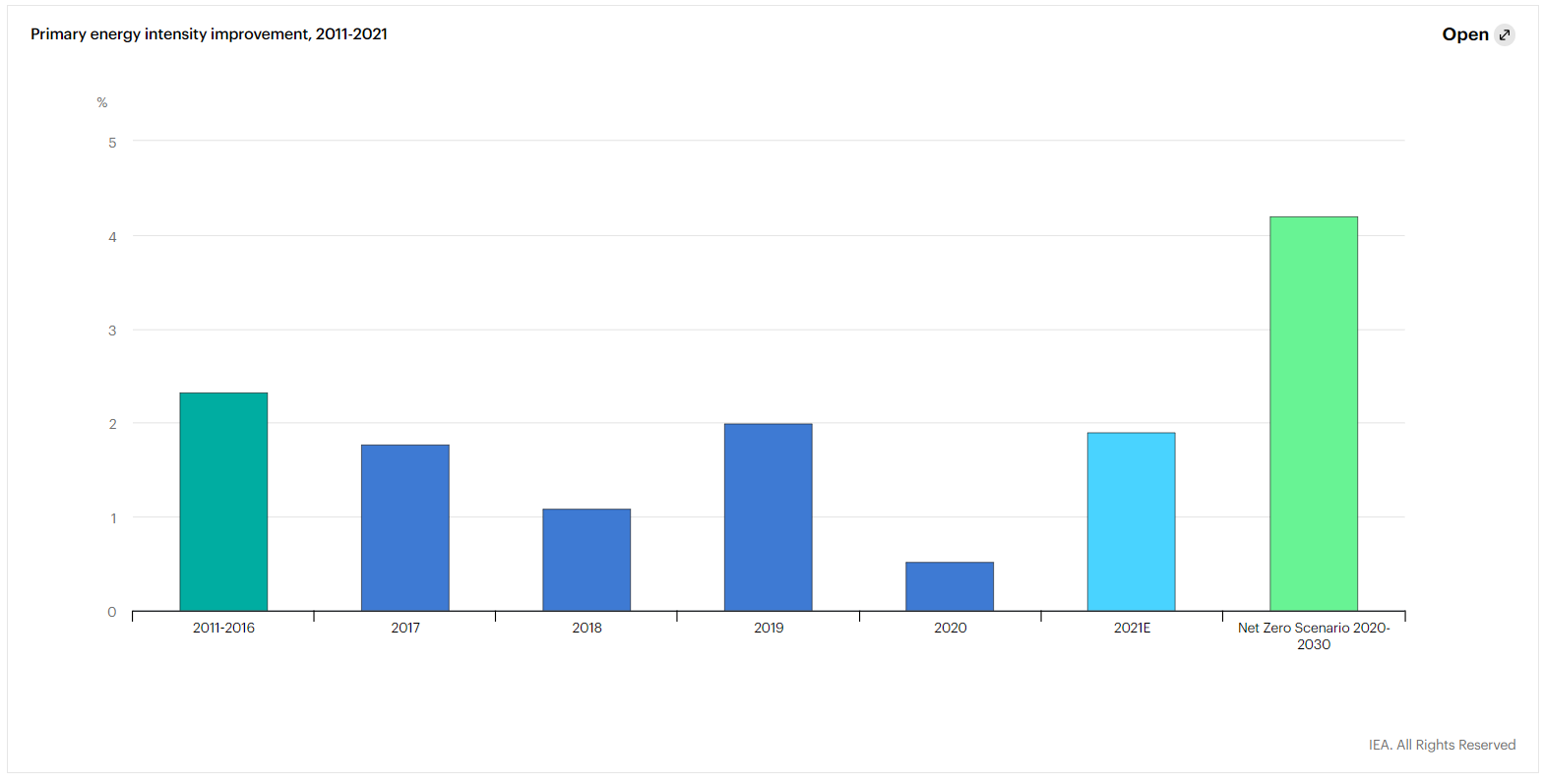Report: To Get to Net-Zero, We Need Energy Efficiency Improvements Now
Let's Save Energy
Alliance to Save Energy's Blog

Last week, representatives from 197 countries signed the Glasgow Climate Pact at COP26 in hopes of limiting global temperature rise from exceeding 1.5 degrees Celsius. Achieving that goal will require rapid carbon emission reductions using a variety of tools, and unfortunately, a report released this week by the International Energy Agency confirms that we are seriously underutilizing one of our hardest-hitting hammers – energy efficiency – potentially to the detriment of meeting the 1.5 degrees limit.
In Energy Efficiency 2021, the IEA found global energy intensity was expected to improve by 1.9% in 2021. That is less than half the annual improvement required to reach net zero by 2050 – the equilibrium of greenhouse gas emissions produced and removed from the atmosphere considered essential for limiting global warming to 1.5 degrees Celsius. While a marked improvement from 2020, when the pandemic’s economic fallout cratered investment in efficiency and led to a just 0.5% improvement, we’re still crawling forward on global efficiency gains when it’s past time to be at a sprint.
Why does efficiency matter for net zero?
The IEA report calls efficiency the “first fuel” because the cleanest, cheapest energy will always be the energy we don’t use. Energy efficiency programs are doing more to reduce emissions than current solar and wind generation combined, saving 1,500 TWh of electricity annually in 2018. In the United States, we would be producing 60% more carbon emissions without the investments made since 1980 in more energy-efficient cars, appliances, buildings, and industry.
But the need is only growing. As the global population grows and as more people have access to electric grids, global energy demand is set to soar, making the challenges of meeting the world’s energy needs through clean sources even more daunting. Additionally, as electrification trends accelerate, particularly with the transition to electric vehicles, U.S. electricity demand will rise by as much as 38% by 2050. This rise in demand makes energy intensity improvements even more critical so that each unit of energy produced goes further. In the IEA’s Net Zero by 2050 roadmap, energy efficiency is identified as one of the key pillars of decarbonization, with a 4% annual improvement in intensity required up to 2030.
Where does deployment of efficiency stand?
It’s obvious that the 1.9% improvement rate found in Energy Efficiency 2021 is not enough. The past five years have averaged a 1.3% improvement per year, down from 2.3% between 2011 and 2016, a concerning slide backward when we need to be increasing to 4%.
Source: International Energy Agency Energy Efficiency 2021.
Investment to achieve accelerated efficiency deployment is also lagging. While around $290 billion was invested globally in building, transportation, and industrial efficiency in 2021, that number needs to triple by 2030 to be on track for net zero. Additionally, this investment is concentrated largely in Europe, with no additional funds beyond existing programs directed toward building efficiency in the U.S. and some regions, including India and Southeast Asia, seeing declines in efficiency investments. One bright spot? The IEA report finds that energy efficiency spending makes up two-thirds of money dedicated to sustainable economic recovery programs globally, raising prospects for increased investment in 2022.
What can be done?
The IEA report calls for doubling improvements in global energy intensity and tripling annual efficiency investments in the years leading up to 2030. Getting there will require a combination of better technologies and better policies. On the former, IEA points out that digital energy technologies are enabling a new level of efficiency – a trend we know as Active Efficiency. Tools like smart thermostats, energy management systems, distributed energy resources, and much more can deepen efficiency gains. But policies and programs are needed to ensure these technologies are available and affordable across the economy; for example, costs can be brought down through federal research and development, rebate programs, tax incentives, and a number of other mechanisms. And these policies aren’t only good for energy and environmental purposes – they’re an enormous economic boon. In fact, scaling up efficiency to meet net zero goals could create 4 million efficiency jobs by 2030. Find out more about efficiency policy solutions here.
Energy efficiency’s foundational role in reaching net zero by 2050 is often overlooked, and the release of the Energy Efficiency 2021 report is a reminder that as we build off momentum from the Glasgow Climate Pact, efficiency must be a top priority in the years ahead.
RECENT BLOG POSTS
STAY EMPOWERED
Help the Alliance advocate for policies to use energy more efficiently – supporting job creation, reduced emissions, and lower costs. Contact your member of Congress.
Energy efficiency is smart, nonpartisan, and practical. So are we. Our strength comes from an unparalleled group of Alliance Associates working collaboratively under the Alliance umbrella to pave the way for energy efficiency gains.
The power of efficiency is in your hands. Supporting the Alliance means supporting a vision for using energy more productively to achieve economic growth, a cleaner environment, and greater energy security, affordability, and reliability.




